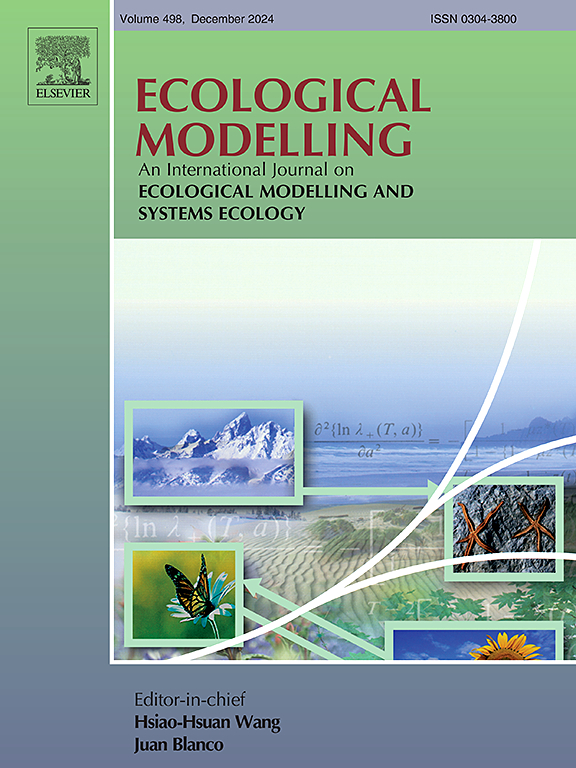Predicting biological control performance under global change using model-based exploration of predator-prey dynamics: application to the Nesidiocoris tenuis - Tuta absoluta system
IF 3.2
3区 环境科学与生态学
Q2 ECOLOGY
引用次数: 0
Abstract
Global change is disrupting our knowledge of ecosystem functioning through climate warming and pest invasion, affecting predator-prey population dynamics. We hypothesized that the control of invasive pests by native predators would decrease with increasing temperatures. We investigated the effects of high temperatures jointly with other factors related to biological control conditions (i.e., habitat complexity reflected by predator searching efficiency, predator-to-prey ratio, and relative timing of species establishment) on predator-prey population dynamics for the zoophytophagous and generalist mirid bug, Nesidiocoris tenuis, and the tomato leaf miner, Tuta absoluta, a native insect predator and an invasive insect pest, respectively, in Senegal. We carried out life history trait measurements in the laboratory at different temperatures (i.e., constant temperatures of 25, 30, 35, 40, and 45 °C and temperatures of 40:35 °C alternating following the light and dark cycle). We developed a stochastic individual-based model to simulate predator and prey population dynamics. Both species were able to complete their life cycle until 35 °C and until 40 °C when the night temperature decreased to 35 °C, while populations persisted over time only at 25 and 30 °C. Contrary to our expectations, pest control increased with temperature due to a higher predation efficiency and asymmetries between insect fitness responses to temperature in favor of the predator. Our study showed that populations of T. absoluta would not increase at high temperatures, either due to successful control by N. tenuis at 30 °C or due to a population collapse at 35 °C and beyond, as T. absoluta approaches its critical thermal maximum. At a temperature less favorable for pest control (25 °C), the timing of predator and pest establishment was the main factor determining the performance of pest control. Control was ensured when the predator established before or close to pest infestation. This can occur with generalist predators that can survive by feeding on alternative resources.
利用基于模型的捕食者-猎物动态探索预测全球变化下的生物防治效果:在Nesidiocoris tenuis - Tuta absoluta系统中的应用
全球变化正在通过气候变暖和害虫入侵破坏我们对生态系统功能的认识,影响捕食者-猎物的种群动态。我们假设本地捕食者对入侵害虫的控制会随着温度的升高而减弱。本文以塞内加尔为研究对象,研究了高温与生物防治条件相关因素(即捕食者搜索效率、捕食者-被捕食者比值和物种建立相对时间所反映的生境复杂性)对植食虫和多面虫(Nesidiocoris tenuis)和番茄采叶虫(Tuta absoluta)捕食者-被捕食者种群动态的影响。我们在不同温度下(即25、30、35、40和45°C的恒定温度和40:35°C的昼夜交替温度)在实验室进行了生活史性状测量。我们建立了一个基于个体的随机模型来模拟捕食者和猎物的种群动态。这两个物种都能在35°C和40°C完成它们的生命周期,当夜间温度下降到35°C时,而种群只能在25°C和30°C持续一段时间。与我们的预期相反,害虫控制随着温度的升高而增加,这是由于更高的捕食效率和昆虫适应度对温度的不对称反应有利于捕食者。我们的研究表明,在高温条件下,绝对T.的种群数量不会增加,这可能是由于在30°C时被N. tenuis成功控制,也可能是由于在35°C及以上的温度下,绝对T.接近其临界热最大值时,种群数量会崩溃。在不利于害虫防治的温度条件下(25℃),捕食者和害虫建立的时机是决定害虫防治效果的主要因素。当捕食者在虫害发生之前或接近虫害发生时,确保控制。这可能发生在多面手捕食者身上,它们可以通过捕食其他资源来生存。
本文章由计算机程序翻译,如有差异,请以英文原文为准。
求助全文
约1分钟内获得全文
求助全文
来源期刊

Ecological Modelling
环境科学-生态学
CiteScore
5.60
自引率
6.50%
发文量
259
审稿时长
69 days
期刊介绍:
The journal is concerned with the use of mathematical models and systems analysis for the description of ecological processes and for the sustainable management of resources. Human activity and well-being are dependent on and integrated with the functioning of ecosystems and the services they provide. We aim to understand these basic ecosystem functions using mathematical and conceptual modelling, systems analysis, thermodynamics, computer simulations, and ecological theory. This leads to a preference for process-based models embedded in theory with explicit causative agents as opposed to strictly statistical or correlative descriptions. These modelling methods can be applied to a wide spectrum of issues ranging from basic ecology to human ecology to socio-ecological systems. The journal welcomes research articles, short communications, review articles, letters to the editor, book reviews, and other communications. The journal also supports the activities of the [International Society of Ecological Modelling (ISEM)](http://www.isemna.org/).
 求助内容:
求助内容: 应助结果提醒方式:
应助结果提醒方式:


